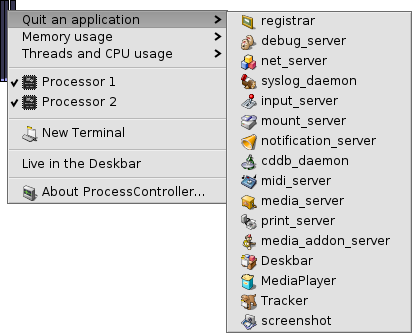 ProcessController
ProcessController
| Barra d'eines: | ||
| Ubicació: | /boot/system/apps/ProcessController | |
| Preferències: | none |
 The primary task of the ProcessController applet is to show the activity of your CPU(s) and the amount of used memory. It allows monitoring of individual teams, change their priority, and kill them if the program freezes. In multiprocessor environments it allows you to disable individual processors/cores.
The primary task of the ProcessController applet is to show the activity of your CPU(s) and the amount of used memory. It allows monitoring of individual teams, change their priority, and kill them if the program freezes. In multiprocessor environments it allows you to disable individual processors/cores.
ProcessController allows putting the system into a mode, at the cost of a slightly increased latency.
Indicators on the left show each CPU's usage, while the bar on the right shows the memory consumption. Remember that the number of indicators depend on the number of processors/cores in the computer.
If not yet running, launching ProcessController asks if it should open in window mode or live in the Deskbar. In window mode you can resize the bar-display by resizing the window and then use the Replicant handle to drag it to the Desktop.
Wherever it's installed, it's operated via a right-click context menu.
To remove the applet again from the Deskbar, uncheck in its context menu.
Quit an application

To quit an application just choose its name from the menu. This is a clean way to close app, just like clicking its close button. Be careful not to quit system processes like servers or daemons, however. Your system may stop working reliably.
Memory usage

Monitoring memory usage can be rather inaccurate.
This menu allows you to monitor memory usage of different teams in your system. Next to the team's name there are two columns: first with the amount reserved for writable memory, while the second shows all memory including read-only space (shared libraries for example).
The first row System resources & caches… shows the total amount of memory used by the system and all applications. The length of the blue bar is based on the total physical memory in your computer. The next rows show memory used by each process. Note that the length of the bar is based only on the actually used part of the memory.
| Memory used only by given application (with write access) | ||
| Memory including read-only space (can be shared with other applications) |
Threads and CPU usage
This menu allows you to change thread priorities, kill teams or debug them.

| Kernel code | ||
| User code | ||
| Idle thread |
At the first level you see team names. By clicking on one, you can kill the whole team. The dark-blue part of the bar is time spent in kernel code, the light-blue part in user code, the green part in the idle thread(s). A bar completely filled with blue means that the team is using all processing power.
The second level shows particular threads of a team. By clicking on one, you can debug or kill it. A bar completely filled with blue means that the thread is pegging one processor/core.
The last level of the menu allows you to change a thread's priority. Be careful with that! As a rule of thumb the priority of a thread should be inverse its CPU usage. That is, the more it tries to claim CPU time, the lower should be its priority. In general, don't mess with an app's priorities; contact its author, that's his business.